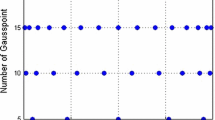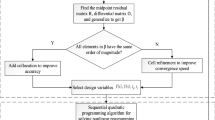Abstract
A new trajectory generation for heat load test is proposed based on gauss pseudospectral method within limit range. Firstly, with multiple path constraints and flight task requirements taken into consideration, heat load parameters are introduced into the dynamics equations. In order to solve the problem of generating such a trajectory within limit range rapidly, the dynamics equations have been normalized by Earth related parameters. Secondly, since the gauss pseudospectral method is just employed to solve the discrete nonlinear programming problem, transformations are developed, which can relate the Lagrange multipliers of the discrete nonlinear programming problem to the costates of the continuous optimal control problem. In addtion, another approach of trajectory generation by tracking the given heat rate is also presented. Finally, simulation results with common aero vehicle (CAV-H) show that the trajectories obtained by both methods can well perform the heat load test with high stagnation heating rate and the large total aeroheating amount; meanwhile, gauss pseudospectral method is better than the compared one in the given range. Furthermore, the 3-D trajectory states and control variables, angle of attack and bank, which are generated by gauss pseudospectral method, can change smoothly.
Similar content being viewed by others


References
Yang M F, Zhang W, Peng J, et al. Technical advancements and significance of circumlunar return and reentry spacecraft. Sci China Tech Sci, 2015, 58: 738–745
Sziroczak D, Smith H. A review of design issues specific to hypersonic flight vehicles. Prog Aerospace Sci, 2016, 84: 1–28
Philippe R. Survey of aerodynamics and aerothermodynamics efforts carried out in the frame of Mars exploration projects. Prog Aerosp Sci, 2014, 70: 1–27
Zhao J S, Gu L X, Ma H Z. A rapid approach to convective aeroheating prediction of hypersonic vehicles. Sci China Tech Sci, 2013, 56: 2010–2024
Dejarnette F R, Cheatwood F M, Hamilton H H, et al. A review of some approximate methods used in aerodynamic heating analyses. J Thermophys Heat Tr, 1987, 1: 5–12
Huo L. The rapid engineering aero-heating calculation and thermal respond for complex shaped hypersonic vehicles. Dissertation of Masteral Degree. Changsha, China: National University of Defense Technology, 2012
Rankins F, Pines D J. Relative heat load comparison of vehicles flying hypersonic transatmospheric trajectories. J Spacecr Rockets, 2000, 37: 491–498
DeJarnette F R, Hamilton H H, Weilmuenster K J. New method for computing convective heating in stagnation region of hypersonic vehicle. In: Aerospace Sciences Meetings of 46th AIAA Aerospace Sciences Meeting and Exhibit. Reno, Nevada, 2008
Hamilton H H, Weilmuenster K J, DeJarnette F R. Approximate method for computing laminar and turbulent convective heating on hypersonic vehicles using unstructured grids. In: Fluid Dynamics and Co-located Conferences of 41st AIAA Thermophysics Conference. San Antonio, Texas, 2009
Harpold JC, Graves CA. Shuttle entry guidance. J Astronaut Sci, 1979, 27: 239–268
Mease K D, Chen D T, Teufel P, et al. Reduced-order entry trajectory planning for acceleration guidance. J Guidance Control Dyn, 2002, 25: 257–266
Zhang Y, Chen K, Liu L, et al. Entry trajectory planning based on three-dimensional acceleration profile guidance. Aerosp Sci Technol, 2016, 48: 131–139
Zoby E V, Thompson R A, Wurster K E. Aeroheating design issues for reusable launch vehicles: A perspective. In: Fluid Dynamics and Co-located Conferences of 34th AIAA Fluid Dynamics Conference and Exhibit. Portland, Oregon, 2004
Zimmerman C, Dukeman G, Hanson J. Automated method to compute orbital reentry trajectories with heating constraints. J Guidance Control Dyn, 2003, 26: 523–529
Joshi A, Sivan K, Amma S S. Predictor-corrector reentry guidance algorithm with path constraints for atmospheric entry vehicles. J Guidance Control Dyn, 2007, 30: 1307–1318
Lu P. Predictor-corrector entry guidance for low-lifting vehicles. J Guidance Control Dyn, 2008, 31: 1067–1075
Xu M L, Chen K J, Liu L H, et al. Quasi-equilibrium glide adaptive guidance for hypersonic vehicles. Sci China Tech Sci, 2012, 55: 856–866
Zhu J, Liu L, Tang G, et al. Highly constrained optimal gliding guidance. Proc I Mech Eng G-J Aer Eng, 2015, 229: 2321–2335
Guo X, Zhu M. Direct trajectory optimization based on a mapped Chebyshev pseudospectral method. Chin J Aeronautics, 2013, 26: 401–412
Benson D. A gauss pseudospectral transcription for optimal control. Dissertation of Doctor Degree. Cambridge: Massachusetts Institute of Technology, 2005
Zhang K N, Chen W C. Reentry vehicle constrained trajectory optimization. In: 17th AIAA International Space Planes and Hypersonic Systems and Technologies Conference. San Francisco, California, 2011
Yan X, Lyu S, Tang S. Analysis of optimal initial glide conditions for hypersonic glide vehicles. Chin J Aeronautics, 2014, 27: 217–225
Xie Y, Liu L H, Tang G J, et al. Trajectory optimization for hypersonic glide vehicle with multi-constraints. J Aeronautics, 2011, 32: 551–572
Garg D, Hager W W, Rao A V. Pseudospectral methods for solving infinite-horizon optimal control problems. Automatica, 2011, 47: 829–837
Benson D A, Huntington G T, Thorvaldsen T P, et al. Direct trajectory optimization and costate estimation via an orthogonal collocation method. J Guidance Control Dyn, 2006, 29: 1435–1440
Author information
Authors and Affiliations
Corresponding author
Rights and permissions
About this article
Cite this article
Zhang, Y., Liu, L., Tang, G. et al. Trajectory generation of heat load test based on gauss pseudospectral method. Sci. China Technol. Sci. 61, 273–284 (2018). https://doi.org/10.1007/s11431-016-9025-3
Received:
Accepted:
Published:
Issue Date:
DOI: https://doi.org/10.1007/s11431-016-9025-3


